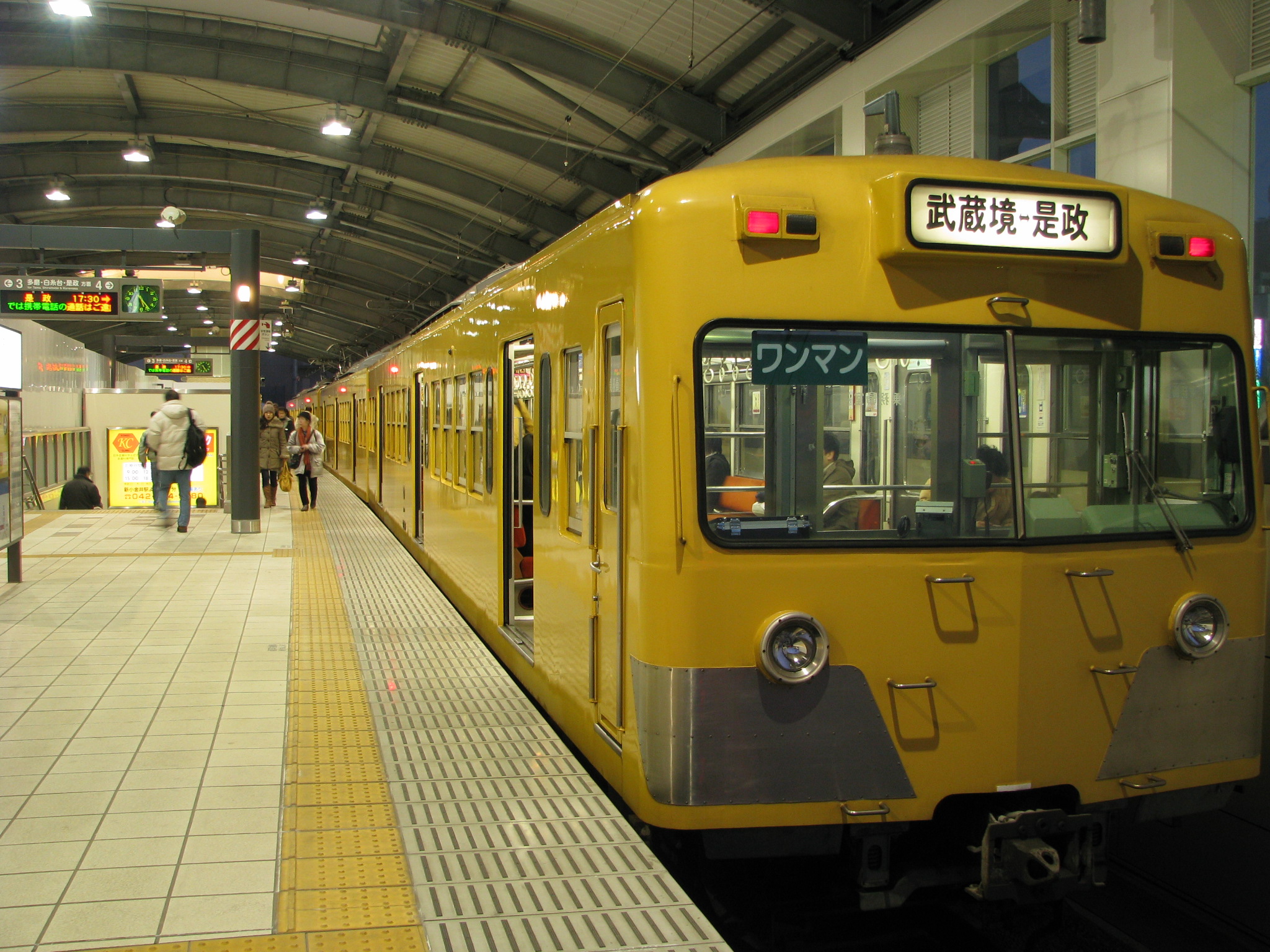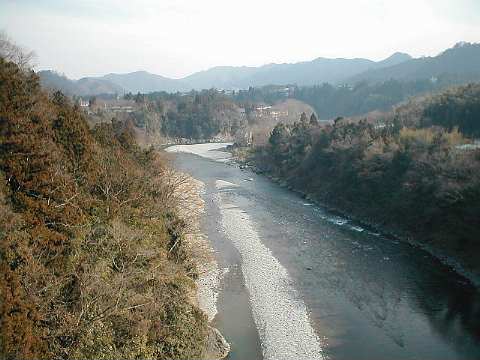|
Koremasa Station
is a passenger railway station located in the city of Fuchū, Tokyo, Japan, operated by the private railway operator Seibu Railway. Lines Koremasa Station is a terminus of the Seibu Tamagawa Line, and is located 8.0 kilometers from the opposing terminus of the line at in Tokyo. Station layout The station has a single side platform serving a single-directional track. Platforms History The station opened on June 20, 1922. Station numbering was introduced on all Seibu Railway lines during fiscal 2012, with Koremasa Station becoming "SW06". Passenger statistics In fiscal 2019, the station was the 72rd busiest on the Seibu network with an average of 7,838 passengers daily. The passenger figures for previous years are as shown below. Surrounding area *Tama River See also * List of railway stations in Japan The links below contain all of the 8579 railway stations in Japan. External links {{Portal bar, Japan, Trains * Railway stations Japan ... References Ex ... [...More Info...] [...Related Items...] OR: [Wikipedia] [Google] [Baidu] |
Seibu Railway
is a conglomerate based in Tokorozawa, Saitama, Japan, with principal business areas in railways, tourism, and real estate. Seibu Railway's operations are concentrated in northwest Tokyo and Saitama Prefecture; the name "Seibu" is an abbreviation of "west Musashi", referring to the historic name for this area. It and its holding company hold shares of numerous bus, hotel and tourism operations nationwide. History "Seibu Railway" was originally the name of a tram service between Shinjuku and Ogikubo, which was transferred to the Tokyo metropolitan government in 1951 and eventually closed in 1962. The Seibu Railway was acquired in 1921 by the Kawagoe Railway, which had operated a train service between Kokubunji and Kawagoe since 1894; the merged company kept the "Seibu" name and expanded its main line to Takadanobaba, forming what is now known as the Seibu Shinjuku Line. The current Seibu Railway is a product of a 1945 merger between the former Seibu Railway and the Musashino R ... [...More Info...] [...Related Items...] OR: [Wikipedia] [Google] [Baidu] |
Seibu Tamagawa Line
The is an 8.0 km railway line in the western suburbs of Tokyo operated by the private railway operator Seibu Railway. The line connects Musashi-Sakai Station on the Chūō Main Line with Koremasa Station along the Tama River. The line has only six stations and is not connected to any other part of the Seibu Railway system. The line is single-track: trains traveling in opposite directions pass each other as necessary at the stations, which are double-tracked. Although the line is short, it provides access to the Tokyo University of Foreign Studies, the Tokyo Racecourse, the Ajinomoto Stadium, the Tokyo Metropolitan Police Department police school, many cemeteries (including Tokyo's largest, Tama Cemetery), the American School in Japan, and the Tama River. Stations Rolling Stock As of March 2010, the line's services are operated exclusively by a fleet of 16 New 101 Series. These trains are wrapped with different liveries on various occasions. However, the New 101 Series ... [...More Info...] [...Related Items...] OR: [Wikipedia] [Google] [Baidu] |
Railway Station
Rail transport (also known as train transport) is a means of transport that transfers passengers and goods on wheeled vehicles running on rails, which are incorporated in Track (rail transport), tracks. In contrast to road transport, where the vehicles run on a prepared flat surface, rail vehicles (rolling stock) are directionally guided by the tracks on which they run. Tracks usually consist of steel rails, installed on Railroad tie, sleepers (ties) set in track ballast, ballast, on which the rolling stock, usually fitted with metal wheels, moves. Other variations are also possible, such as "slab track", in which the rails are fastened to a concrete foundation resting on a prepared subsurface. Rolling stock in a rail transport system generally encounters lower friction, frictional resistance than rubber-tyred road vehicles, so passenger and freight cars (carriages and wagons) can be coupled into longer trains. The rail transport operations, operation is carried out by a ... [...More Info...] [...Related Items...] OR: [Wikipedia] [Google] [Baidu] |
Fuchū, Tokyo
260px, Fuchū City Hall is a city located in western Tokyo Metropolis, Japan. Fuchū serves as a regional commercial center and a commuter town for workers in central Tokyo. The city hosts large scale manufacturing facilities for Toshiba, NEC and Suntory, as well as the Bank of Japan's main computer operations center. Local sporting attractions include the Tokyo Racecourse and the training grounds of Top League rugby teams Toshiba Brave Lupus and Suntory Sungoliath. , the city had an estimated population of 260,508, and a population density of 8,900 persons per square kilometer. The total area of the city is . Geography Fuchū is located approximately 20 km west of the centre of Tokyo. Using the Keiō Line from Shinjuku, it is 25 minutes to Fuchū Station (main station). It spreads across the Musashino Terrace on the left bank of the Tama River, facing the Tama hills on the opposite shore. The Tama River flows through the southernmost end of the city from west ... [...More Info...] [...Related Items...] OR: [Wikipedia] [Google] [Baidu] |
Terminal Station
A train station, railway station, railroad station or depot is a railway facility where trains stop to load or unload passengers, freight or both. It generally consists of at least one platform, one track and a station building providing such ancillary services as ticket sales, waiting rooms and baggage/freight service. If a station is on a single-track line, it often has a passing loop to facilitate traffic movements. Places at which passengers only occasionally board or leave a train, sometimes consisting of a short platform and a waiting shed but sometimes indicated by no more than a sign, are variously referred to as "stops", " flag stops", " halts", or "provisional stopping places". The stations themselves may be at ground level, underground or elevated. Connections may be available to intersecting rail lines or other transport modes such as buses, trams or other rapid transit systems. Terminology In British English, traditional terminology favours ''railway ... [...More Info...] [...Related Items...] OR: [Wikipedia] [Google] [Baidu] |
Side Platform
A side platform (also known as a marginal platform or a single-face platform) is a railway platform, platform positioned to the side of one or more railway tracks or guideways at a railway station, tram stop, or bus rapid transit, transitway. A station having dual side platforms, one for each direction of travel, is the basic design used for double-track railway lines (as opposed to, for instance, the island platform where a single platform lies between the tracks). Side platforms may result in a wider overall footprint for the station compared with an island platform where a single width of platform can be shared by riders using either track. In some stations, the two side platforms are connected by a footbridge running above and over the tracks. While a pair of side platforms is often provided on a dual-track line, a single side platform is usually sufficient for a single-track line. Layout Where the station is close to a level crossing (grade crossing) the platforms may ei ... [...More Info...] [...Related Items...] OR: [Wikipedia] [Google] [Baidu] |
Tama River
The is a major river in Yamanashi, Kanagawa and Tokyo Prefectures on Honshū, Japan. It is officially classified as a Class 1 river by the Japanese government. Its total length is , and the total of the river's basin area spans . The river flows through Tokyo, on the dividing line between Tokyo and Kanagawa. In the city, its banks are lined with parks and sports fields, making the river a popular picnic spot. Course The Tama's source is located at Mt. Kasatori in Koshu in Yamanashi Prefecture. From there, it flows eastward into mountainous western Tokyo, where the Ogōchi Dam forms Lake Okutama. Below the dam, it takes the name Tama and flows eastwards through Chichibu Tama Kai National Park towards Ōme, Tokyo. It then flows southeast between Tama Hills and Musashino Terrace. At Hamura is the source of the historic Tamagawa Aqueduct built by the Tamagawa brothers in 1653 to supply water to Edo (present day Tokyo). Further downstream, the river forms the boundary ... [...More Info...] [...Related Items...] OR: [Wikipedia] [Google] [Baidu] |
Railway Stations In Japan Opened In 1922
Rail transport (also known as train transport) is a means of transport that transfers passengers and goods on wheeled vehicles running on rails, which are incorporated in tracks. In contrast to road transport, where the vehicles run on a prepared flat surface, rail vehicles (rolling stock) are directionally guided by the tracks on which they run. Tracks usually consist of steel rails, installed on sleepers (ties) set in ballast, on which the rolling stock, usually fitted with metal wheels, moves. Other variations are also possible, such as "slab track", in which the rails are fastened to a concrete foundation resting on a prepared subsurface. Rolling stock in a rail transport system generally encounters lower frictional resistance than rubber-tyred road vehicles, so passenger and freight cars (carriages and wagons) can be coupled into longer trains. The operation is carried out by a railway company, providing transport between train stations or freight customer facilit ... [...More Info...] [...Related Items...] OR: [Wikipedia] [Google] [Baidu] |
Railway Stations In Tokyo
Rail transport (also known as train transport) is a means of transport that transfers passengers and goods on wheeled vehicles running on rails, which are incorporated in Track (rail transport), tracks. In contrast to road transport, where the vehicles run on a prepared flat surface, rail vehicles (rolling stock) are directionally guided by the tracks on which they run. Tracks usually consist of steel rails, installed on Railroad tie, sleepers (ties) set in track ballast, ballast, on which the rolling stock, usually fitted with metal wheels, moves. Other variations are also possible, such as "slab track", in which the rails are fastened to a concrete foundation resting on a prepared subsurface. Rolling stock in a rail transport system generally encounters lower friction, frictional resistance than rubber-tyred road vehicles, so passenger and freight cars (carriages and wagons) can be coupled into longer trains. The rail transport operations, operation is carried out by a ... [...More Info...] [...Related Items...] OR: [Wikipedia] [Google] [Baidu] |

.jpg)


